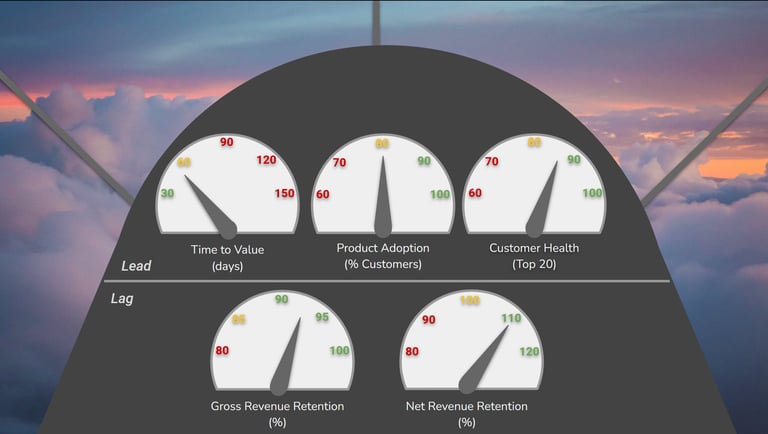A Simple CX Dashboard for Success
No one should fly a plane without an instrument panel. Neither should you operate a business without your own measurements. Customer experience being one of two major predictors of your valuation, not having a CX Dashboard is like flying blind.
CUSTOMER EXPERIENCECUSTOMER SUCCESS
Joseph Loria
12/30/20233 min read


Why You Need a Simple CX Dashboard
Measuring CX success, I’ve always said, is the easy part. Because what to measure, and what the desired target values should be, are fairly well known. Wondering whether your customer experience is succeeding or not? Start with measurement.
The first things to measure are the end results, or “lag” measures of success. These tell you in the aftermath how you did. In forecast mode, lag measures predict how those results will wind up. They’re not actionable, but they are the obvious indicators of success that everyone understands. They are:
Gross Revenue Retention (GRR)
Net Revenue Retention (NRR)
Gross Revenue Retention
GRR is the percentage of recurring revenue retained from existing customers, including downgrades and cancellations but excluding expansion from upsells, cross-sells, or upgrades. It’s also known as “Gross Dollar Retention” or “Gross Punitive Retention.” The key is that this is a punitive measure. Typically a trailing-twelve-months (TTM) calculation, GRR looks at the customer cohort from one year ago and asks: What are they paying now versus then for the subscriptions they had a year ago?
GRR = (Beginning ARR - Churned ARR - Downgraded ARR) / Beginning ARR
Net Revenue Retention
NRR is the same as GRR with one change: it includes expansion from upsells, cross-sells, and upgrades. It’s also known as Net Dollar Retention. Also a trailing-twelve-months (TTM) calculation, NRR is as follows:
NRR = (Beginning ARR - Churned ARR - Downgraded ARR + Expanded ARR) /Beginning ARR
Imagine a cockpit instrument panel with these measurements, these two lag indicators showing past success or (as forecasted values) predictors of eventual success.
But cockpit gauges with only lag measures are pretty useless for ongoing guidance. Once you see “red” on a lag gauge, it’s often too late to react. You also need predictive or “lead” measures to help with guidance. Lead measures have mutual benefits:
They tell you if you’re on the right track;
They’re actionable;
They feed into predictions for the lag measures.
There are three basic areas of predictive CX measurement you must have.
Time to Value
The primary predictor of high GRR is short time to value (TTV). The bottom line is that, if your customer doesn’t see real and measurable value from your offering in the first few months with you, they won’t stay with you. Calculating TTV is easy:
TTV (Days) = Date of First Value - Sold Date
Notice, however, that you’ll need to know exactly what “first value” is. It’s that first use case (or set of use cases) a customer experiences measurable value from. Know this, define it, track it, and make sure the time from Sold Date to First Value is less than 90 days if at all possible.
Adoption
Whether you’re offering a product or a service, your customers can’t experience value from your offering unless they actually use it. Usage is the foundation of value. Value realization looks something like:
Usage -> Process Change -> KPI Change -> Value Realization
Since it all starts with usage, you must measure that as a predictor.
If you’re a product offering, this is usually easy, as you’ll have product analytics. For service offerings, you need to forge a bit into process change to ensure adoption. Regardless, measure adoption, and work to ensure that at least 80% of your customers are adopting key use cases.
Customer Health
Lastly, you need to have some objective measure of customer health. Absent customer health scores, you’re flying blind and have no visibility to risks ahead with your largest revenue customers.
Health scoring is the hardest of the predictive measures, but it’s also the easiest to experiment with and treat in an agile fashion. A basic start to health scoring could include:
Risk factors that derail onboarding or adoption;
Success factors that “good” customers consistently demonstrate.
Risk and success factors are usually two sides of the same coin. For example, one risk factor is a lack of usage, whereas a success factor is solid usage of specific features. Another risk factor might be having the wrong customer roles involved in adoption, whereas a success factor might be having the right customer roles intimately involved.
Use both the positive and negative views to get the full picture. Create a draft version of a health score, start using it, and allow the eventual churn and renewal data to correlate the model. Rinse and repeat to fine-tune your scoring and get true prediction.
Conclusion
No one should fly a plane without an instrument panel. Neither should you operate a business without your own gauges. Customer experience being one of two major predictors of your valuation, not having measurement gauges for CX is like flying blind. Define and measure key metrics to ensure you’re maximizing the business value you’re creating.
